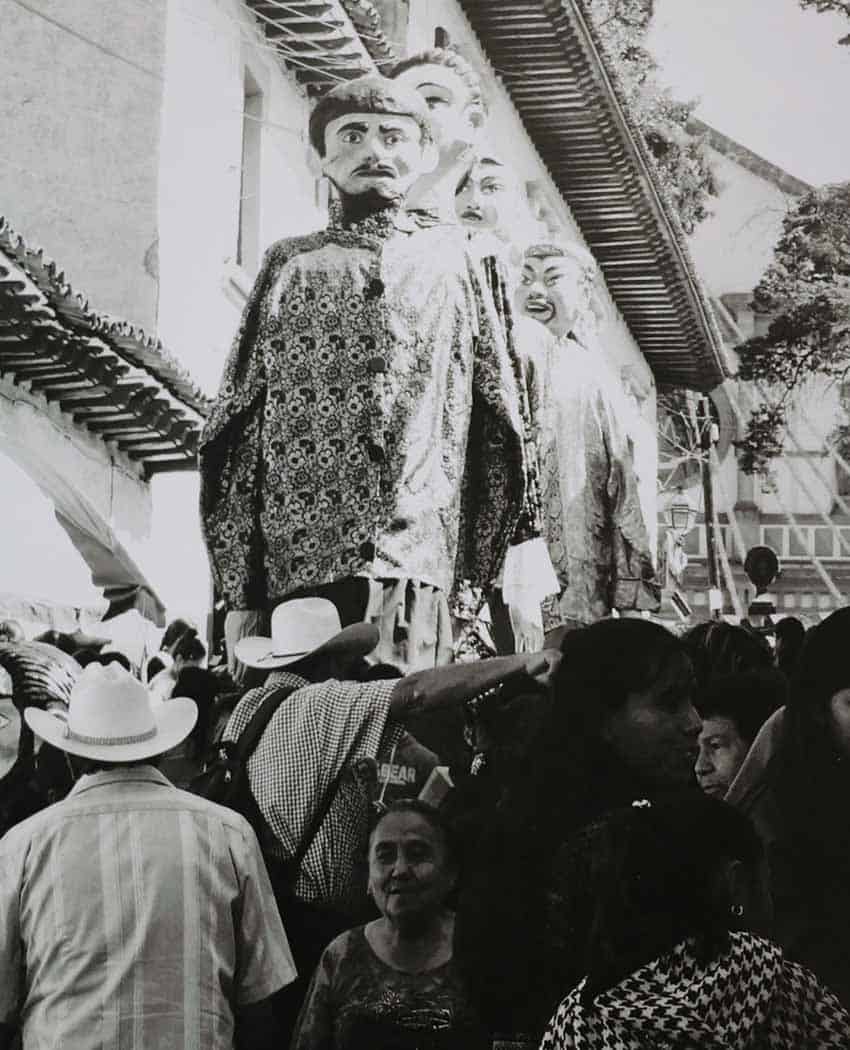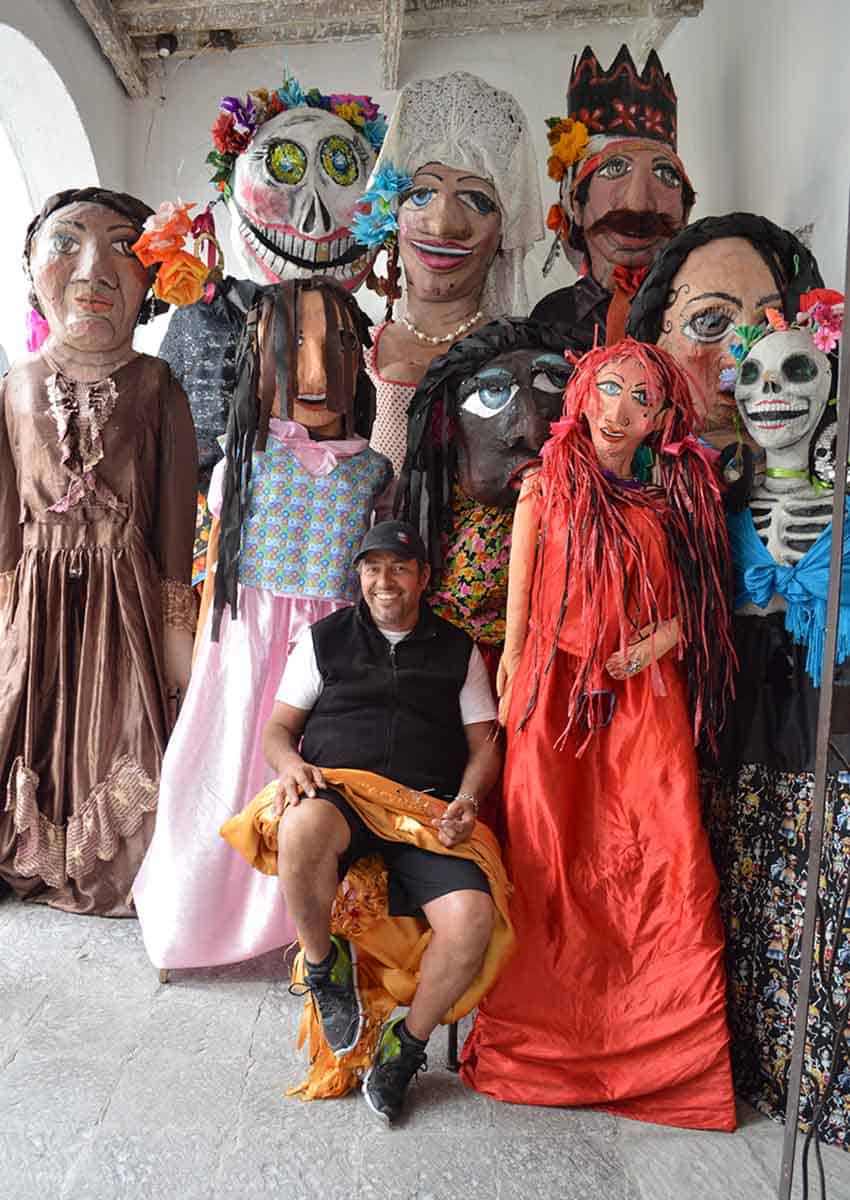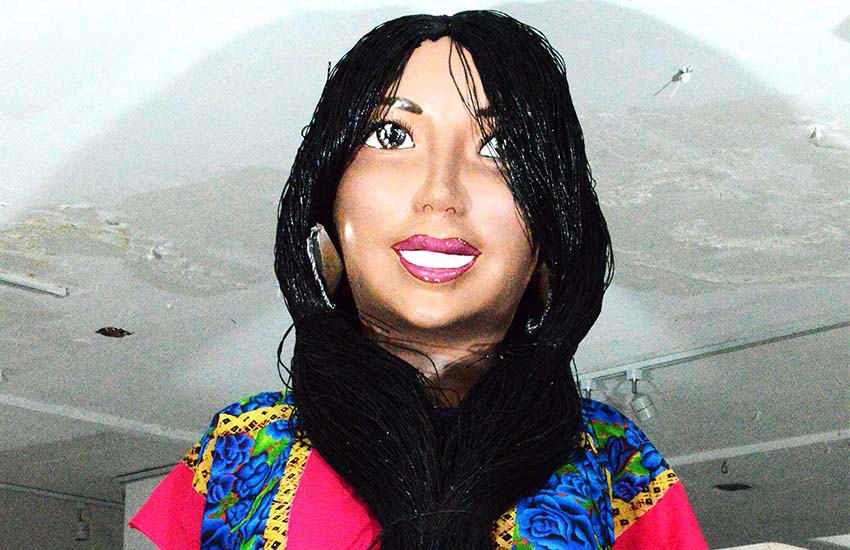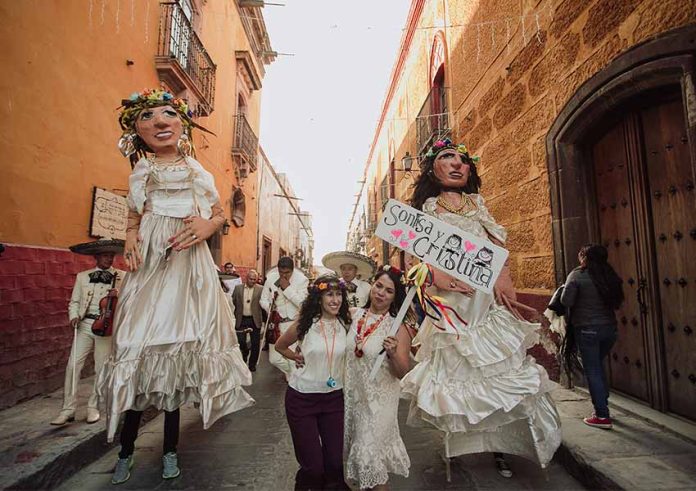San Miguel de Allende, Guanajuato, made them internationally famous, but Mexico’s gigantic puppets are much more than a tourist attraction.
They can go by various names like mona de calenda and gigantes, but the best-known term is mojiganga, so we will use that here.
The word comes from Spain, where it originally referred to a kind of street theater, often associated with religious processions, included to provide comic relief. This use can be found in Mexico in a few places like Zacualpan de Amilpas, Morelos. Their mojiganga event occurs along with the celebration of its patron saint, la Virgen del Rosario (the Virgin of the Rosary), in September.
But the word mojiganga has mostly shifted meaning to refer to a meters-tall puppet figure made to sit on the shoulders of a person who dances along the street as public entertainment. The dancer/puppeteer is hidden by the skirt or robe of the figure, with a hole cut out to allow the dancer to peer through.
Across Mexico, there are few hard-and-fast rules for making a mojiganga, but almost always, they are a mixed-media creation. At the very least, the head of the puppet is made from papier-mâché, not only because of its lack of weight but also because the facial features can be as simple or as fine as the artisan wants.

In most places, the papier-mâché “skin” extends down the torso, generally reinforced with wood or metal. In Celaya, a town famous for its papier-mâché work, the entire figure is made with papier-mâché, but just about everywhere else, they take advantage of other materials.
Arms are generally of stuffed cloth to allow them to sway freely and not hurt anyone who might get hit by them. The clothing is made with commercial fabric, often colorful, and the extension of this cloth down past the waist is what hides all of the dancer except for his feet, which become part of the image. Hair can be made with any of a number of materials, and certain items like jewelry can be purchased commercially or made from scratch.
Depending on the area and the purpose of the puppet, the forms that mojigangas take vary widely. They can include buxom blondes in revealing attire, brides, grooms, Mexican historical figures, devils, angels, pre-Hispanic priests, modern indigenous people, Mexican cultural figures and occasionally homages to non-Mexican persons such as Gandhi and Albert Einstein.
Some forms are dictated by tradition, such as the “turcos” and “orientales” figures in Pátzcuaro, referencing Spain’s history with the Moors, as well as the heroes of the War of Independence who must appear in San Miguel de Allende’s annual “El Grito” celebration on the night before Independence Day. Others, however, can take advantage of various cultural images and even be pure flights of fancy.
How, where and when they appear is not uniform either. They show up spottily in central Mexico, primarily in the states of Guanajuato, Michoacán, Guerrero and Oaxaca. Even in these states, they are mostly limited to San Miguel Allende, Pátzcuaro, and in Oaxaca in Oaxaca city, Santo Tomás Jalieza, and Cuilápam, where their use has been documented for centuries.
They appear most often at patron saint festivities. In places like Pátzcuaro, they are used only for this purpose. But in many other places, locals employ them for a wider variety of uses.

San Miguel’s most famous mojigangas are those made for weddings, and this is the case in Oaxaca as well. Another common use is as a means of attracting customers to a business, often in Mexican restaurants and tourist shops. More recently, mojigangas have appeared in some Day of the Dead celebrations, particularly those festivals aimed at tourists.
Although guaranteed to attract attention no matter how they are used, the larger-than-life puppets are not cheap. They cost a minimum of 6,000 pesos to produce but can fetch three times that in wealthier parts of the country.
Dancing as a mojiganga is no mean feat. Straps at the puppet’s hips put all the weight on the dancer’s shoulders. San Miguel de Allende maker Hermes Guerrero says that he tries to keep the weight of his creations down as much as possible, but they are still over 20 kilograms. He has also found that replacing the braided rope straps with those made with rubber inner tubes not only makes the weight a bit easier to bear but also makes the puppet bounce more.
The mojigangas of San Miguel de Allende are the most famous because, quite simply, the large expat population there has brought them to the attention of the international press.
It would be easy to mistakenly believe that they were invented here and used only for partying purposes — not the case. Mojigangas were introduced into colonial Mexico by at least the 17th century, and their use was likely more widespread then than it is now.
Pátzcuaro historian Eugenio Calderon says the tradition almost disappeared for a time after the Revolution because of the outlawing of public religious displays. However, their use probably had been waning before that because, while religious festivities with comic/party-like elements are widespread in Mexico, the use of mojigangas is not.

As for just being party favors, far older traditional uses of mojigangas remain, even outside of San Miguel’s touristy center, including some in which the dancing figure is made for a particular folk religious festival, then ritually burned.
There are a number of noted mojiganga makers in Mexico. Maestro Arroyo has the advantage of being based in San Miguel de Allende, where his wedding and other commercial creations often pay for the ones that he makes for local community celebrations.
There is evidence that the puppets’ use is slowly growing and spreading into new areas of Mexico: artisans such as Arroyo, Tonatiuh Estrada from Oaxaca and more are finding business outside their local areas.
Estrada did not begin his crafting career with the puppets. Originally a woodworker, he became disheartened with the inability to purchase wood that was not harvested illegally. He began by reestablishing local traditions but now ships mojigangas all over Mexico, particularly to the west and northwest of the country.
It is easy to get caught up with the party and commercial aspects of these creations, but they are an important part of Mexico’s history and culture. YouTube video blogger of Mexican culture and gastronomy, Carlos el Casta says, “These mojigangas are an important part of our history and identity. They serve to reinforce a sense of community while they entertain.”
Leigh Thelmadatter arrived in Mexico 18 years ago and fell in love with the land and the culture in particular its handcrafts and art. She is the author of Mexican Cartonería: Paper, Paste and Fiesta (Schiffer 2019). Her culture column appears regularly on Mexico News Daily.
